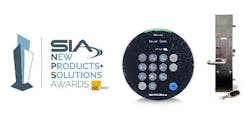10 Years Ago
“The Second Credential” looked at the increases in security when a biometric credential is combined with a PIN or card. A hands-on article covered servicing Kwikset/Weiser locks with the Kwikset SmartCode Decoding Tool from Lockmasters. Gale Johnson refurbished a 40-year-old Corbin handleset for a homeowner’s front entrance. Jerry Levine described a retrofit delayed egress system using the RCI DE8310CV delayed egress series electromagnetic lock. Tim O’Leary concluded a two-part series on specifying, running and terminating wires for electronic access control installations. “Airport Security Solution, No Wires Attached” described how Medeco eCylinders offered audit control and peace of mind at Roanoke Blacksburg Regional Airport. The Major Manufacturing Jamb Jacket for provided a repair solution that strengthened broken wooden door jambs. “Security Strike Plates: The Other Side of Door Hardware” focused on Pro-Lok’s EntryArmor line of strike plates.
20 Years Ago
Tom Gillespie suggested that locksmiths should look beyond the lock and when out on a job and see if additional items such as hinges need replacing. Jerry Levine reported on the Marks USA Protector mortise lock. Locksmith Ledger also reported on DORMA CL870 cylindrical locks. Dale Bowman introduced the new Medeco3 Biaxial cylinder lineup. Rod Oden provided an epic master key article on ways to use the key bitting array. Jerry Levine tested the Smart-Clone by Jet Hardware. Tim O’Leary described how basic alarm systems could be easily installed. Lockmasters Security Institute dedicated their new training facility. Ingersoll Rand products were shown installed at Long Island University. Tiny serviced the locks on a 2005 Chevrolet Equinox. Steve Kaufman interviewed Ted Gula, locksmith and inventor of a key cutting system for Sargent sectional keys. Locksmith Ledger reported on the TD3000 Transponder Detector by Bianchi. The National Average Price for service calls in 2004 was $47.
Retrofit Hardware Opportunities: Upgrading Mechanical Locks
Editor’s Note: Though the product selection has changed since this article first appeared in 2014, there are still many commercial openings in need of retrofit security upgrades.
The passage of time, use and abuse, life/safety concerns, new technology and designs and new code requirements result in the need to upgrade lock hardware in commercial and institutional applications. Choosing a replacement lock can be as simple as installing the same lock manufacturer's leverset where a knobset was previously, or as complex as implementing an electromechanical access control system throughout an entire facility.
Vandal resistant cylindrical and mortise locks are designed to resist abusive acts without unlocking or being damaged. An example is the introduction of the "clutch" mechanism. School security locks are equipped with indicators that visually verify whether the classroom door lock is locked or unlocked.
Cylindrical Lock Replacement
When replacing a cylindrical or mortise lock with a different type or brand of lock, there are several things to consider.
- Door prep through bolt locations for cylindrical leversets.
- Lock cylinder dimensions in the exterior lever.
- Diameter of the rose
Cylindrical locks have been upgraded to include a clutch mechanism that disengages the exterior lever from the latch retraction mechanism when locked. Should the exterior lever be force rotated in the locked condition, the lever will either stop against a stop or disengage when force rotated. Depending upon the lock manufacturer, the term Vandal Resistant can be used on this type of lock or locks that have additional mechanisms to resist unauthorized access.
Special application cylindrical locks include ligature resistant and locks equipped with hospital push-pull handles.
Mechanical Pushbutton Locks
Mechanical pushbutton locks offer an alternative to carrying a key. These pushbutton locks are easy to program. Most do not have to be removed from the door in order to change the code. They use a single access code, usually three to 10 digits in length (so users have the option of memorizing an area code and telephone number as the code). Locks can be ANSI/BHMA Grade 1 or 2 certified. Mechanical pushbutton locks are available for different applications including trim for an exit device. Most commercial pushbutton locks are equipped with a key override lock cylinder.
The electrical upgrade for cylindrical locks includes either a solenoid or motor to lock or unlock the latching mechanism to be part of an electronic access control system. Some electrified cylindrical locks are available with a request-to-exit (REX) output.
Mortise Lock Considerations
Installing a different lock manufacturer’s mortise lock has its own set of considerations. These include the size of the mortise body (height and depth), the location of the latch bolt and deadbolt (if equipped), the locations of the hub and the mortise cylinder/thumbturn opening. With any differences in the new mortise body, the existing trim may not be compatible. Sometimes rose trim can be relocated and still provide sufficient coverage without having to replace the trim.
Read the full article at www.locksmithledger.com/12001355






